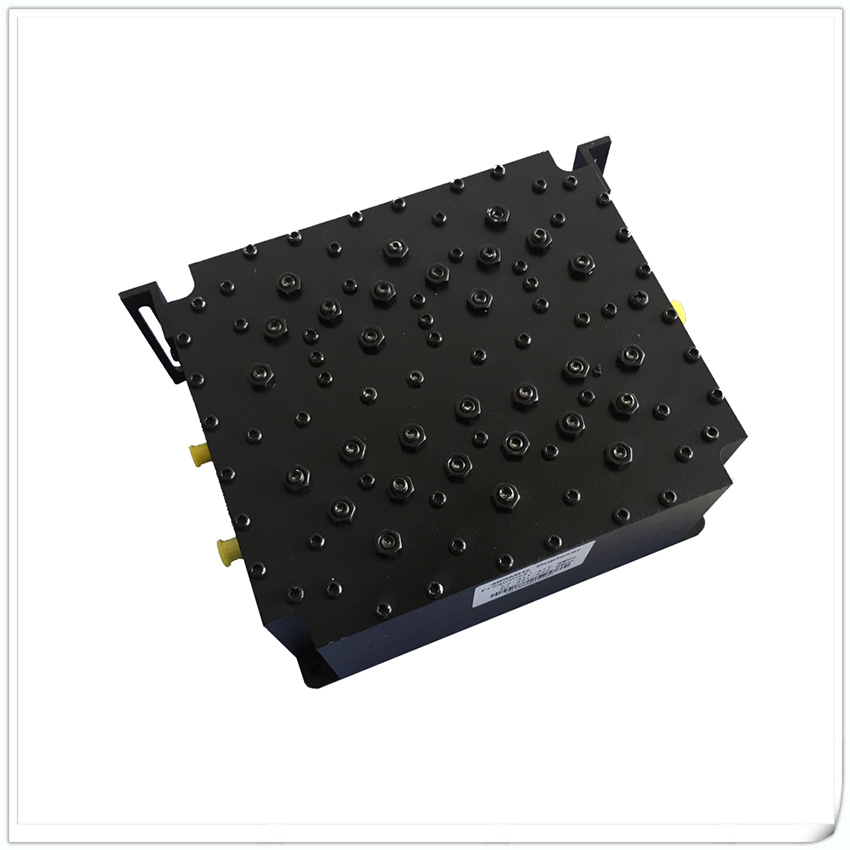
Products
RF Duplexer
Data Sheet
| Frequency (MHz) |
IL. ≤(dB) |
Rejection | VSWR ≤ |
Power (CW) |
Connector | Temp. (°C) |
Dimension LxWxH(mm) |
Model No. | |
| Rx | 136-138 | 1.5 | ≥70dB@143-145MHz | 1.3 | 75 | N | -30~+75 | 310*148*156 | DUP-136M143-02N |
| Tx | 143-145 | 1.5 | ≥70dB@136-138MHz | ||||||
| Rx | 155.1-156.1 | 1.5 | ≥75dB@161-162MHz | 1.3 | 80 | N | -20~+60 | 310*148*156 | DUP-151M161-01N |
| Tx | 161-162 | 1.5 | ≥75dB@155.1-156.1MHz | ||||||
| Rx | 158-160 | 0.8 | ≥70dB@162.5-164.5MHz | 1.25 | 200 | N | -30~+60 | 430*310*150 | DUP-158M162-02N |
| Tx | 162.5-164.5 | 0.8 | ≥70dB@158-160MHz | ||||||
| Rx | 240-270 | 1.0 | ≥80dB@40-220MHz ≥80dB@290-1800MHz ≥50dB@1800-2200MHz |
1.3 | 10 | SMA | -40~+75 | 260*190*65 | DUP-240M340-30A40S |
| Tx | 340-380 | 1.0 | ≥80dB@40-320MHz ≥80dB@410-1800MHz ≥50dB@1800-2200MHz |
||||||
| Rx | 351-356 | 1.6 | ≥30dB@358.5MHz ≥85dB@361-366MHz |
1.3 | 80 | Rx:SMA Tx:SMA ANT:N Lengthening |
-20~+60 | 177.5*134.5*85 | DUP-351M361-05SNS |
| Tx | 361-366 | 1.6 | ≥30dB@358.5MHz ≥85dB@351-356MHz |
||||||
| Rx | 385-390 | 1.7 | ≥40dB@392.5MHz ≥85dB@395-400MHz |
1.3 | 50 | SMA | -20~+60 | 177.5*134.5*85 | DUP-385M395-05S |
| Tx | 395-400 | 1.7 | ≥40dB@392.5MHz ≥85dB@385-390MHz |
||||||
| Rx | 403.5-408.5 | 1.8 | ≥75dB@ 413.5-418.5 MHz ≥30dB@ 398.5MHz(20℃) |
1.25 | 75 | SMA | -25~+55 | 260×72×68 | DUP-403.5M413.5-05S |
| Tx | 413.5-418.5 | 1.8 | ≥75dB@ 403.5-408.5 MHz ≥30dB@ 423.5MHz(20℃) |
||||||
| Rx | 412-417 | 1.7 | ≥40dB@419.5MHz ≥85dB@422-427MHz |
1.3 | 50 | SMA | -20~+60 | 177.5*134.5*85 | DUP-412M422-05S |
| Tx | 422-427 | 1.7 | ≥40dB@419.5MHz ≥85dB@412-417MHz |
||||||
| Rx | 450-500 | 0.5 | ≥60dB@758-865MHz | 1.3 | 50 | SMA | -20~+60 | 160*83*53 | DUP-450M758-50A107S |
| Tx | 758-865 | 0.5 | ≥60dB@450-500MHz | ||||||
| Rx | 457-459 | 2.0 | ≥95dB@467-469MHz | 1.3 | 50 | SMA | -30~+60 | 280*100*68 | DUP-457M467-02S |
| Tx | 467-469 | 2.0 | ≥95dB@457-459MHz | ||||||
| Rx | 703-748 | 1.5 | ≥30dB @ 753MHz ≥85dB @ 758-803MHz |
1.25 | 40 | SMA | -20~+65 | 287*87*48 | DUP-703M758-45S |
| Tx | 758-803 | 1.5 | ≥30dB @ 753MHz ≥85dB @ 703-748MHz |
||||||
| Rx | 824-849 | 1.5 | ≥80dB @ 869-894MHz | 1.3 | 50 | SMA | -20~+60 | 192*60*45 | DUP-824M869-25S |
| Tx | 869-894 | 1.5 | ≥80dB @ 824-849MHz | ||||||
| Rx | 1150-1300 | 0.4 | ≥80dB@1530-1630MHz | 1.3 | 100 | N | -20~+60 | 135*100*43 | DUP-1150M1530-150A100S |
| Tx | 1530-1630 | 0.4 | ≥80dB@1150-1300MHz | ||||||
| Rx | 1215-1261 | 0.3 | ≥60dB@1550-1610MHz | 1.3 | 300 | N | -20~+60 | 180*93*50 | DUP-1215M1550-46A60NA |
| Tx | 1550-1610 | 0.3 | ≥60dB@1215-1261MHz | ||||||
| Rx | 1215-1261 | 0.3 | ≥60dB@1550-1610MHz | 1.3 | 500 | N | -20~+60 | 220*113*56 | DUP-1215M1550-46A60NB |
| Tx | 1550-1610 | 0.3 | ≥60dB@1215-1261MHz | ||||||
| Rx | 1518-1676 | 1.2 | ≥80dB@Sideband ±100MHz |
1.3 | 50 | SMA | -25~+60 | 160*105*43 | DUP-1518M1920-157A105S |
| Tx | 1920-2025 | 1.2 | ≥80dB@Sideband ±100MHz |
||||||
| Rx | 1710-1785 | 1.5 | ≥5@1700MHz ≥5@ 1790MHz ≥55dB@1795MHz(20℃) ≥85dB@1805-1880MHz |
1.3 | 50 | SMA | -20~+65 | 180*98*43 | DUP-1710M1805-75S |
| Tx | 1805-1880 | 1.5 | ≥5@1800MHz ≥10@ 1890MHz ≥55dB@1795MHz(20℃) ≥85dB@1710-1785MHz ≥80@1920-2700MHz |
1.3 | |||||
| Rx | 1710-1785 | 1.2 | ≥80dB@1805-1880MHz | 1.3 | 100 | Rx:SMA Tx:SMA ANT:N Lengthening |
-20~+65 | 161*120*43 | DUP-1710M1805-75SNS |
| Tx | 1805-1880 | 1.2 | ≥80dB@1710-1785MHz | 1.3 | |||||
| Rx | 2490-2520 | 1.4 | ≥90dB@DC-2450MHz ≥90dB@2620-6000MHz |
1.3 | 5 | Rx:SMA Tx:SMA ANT:N |
-20~+60 | 192*88*40 | DUP-2490M2610-30SNS |
| Tx | 2610-2640 | 1.4 | ≥90dB@DC-2570MHz ≥90dB@2740-6000MHz |
1.3 | |||||
| Rx | 2500-2700 | 1.3 | ≥45@ 2595MHz ≥90@2620-2690MHz |
1.3 | 50 | SMA | -30~+60 | 192*88*48 | DUP-2500M2620-70S |
| Tx | 2620-2690 | 1.3 | ≥45@ 2595MHz ≥90@2500-2570MHz |
1.3 | |||||
| Rx | 2515-2675 | 0.6 | ≥80dB@3400-3600MHz | 1.3 | 20 | SMA | -25~+70 | 100*45*30 | DUP-2515M3400-160A200S |
| Tx | 3400-3600 | 0.6 | ≥80dB@2515-2675MHz | 1.3 | |||||
Overview
The two main components of a cavity duplexer are the transmitting cavity and the receiving cavity.
The high isolation, low insertion loss, reliability, and stability of cavity diplexers give them great advantages in wireless communication systems.
Cavity diplexers play a crucial role in wireless communication systems, particularly suitable for scenarios where both sending and receiving signals are required to coexist in the same frequency band. For example, communication between base stations and mobile devices, communication between wireless stations and monitoring devices, etc. By using cavity diplexers, the system can achieve efficient and reliable bidirectional communication.










